Cell Reference Power
This tutorial shows how Amari Callbox specify Cell Reference Power for each radio technology (NR SA, LTE, NB IoT) and how you can verify it. CellReferencePower indicates the power of reference signal that is transmitted by eNB/gNB. UE compares this value broadcasted by SIB and the reference power it measures, and estimate the downlink pathloss based on the result. Regardless of radio access technology, all radio technology broadcast this information (reference power) in one of SIBs. The IE (information element) name for each of the radio technology is as follows :
- NR : ss-PBCH-BlockPower
- LTE : referenceSignalPower
- NB IoT : nrs-Power-r13
Table of Contents
- Cell Reference Power
- Introduction
- Summary of the Tutorial
- Test Setup
- Configuration
- NR SA Cell Reference Power
- LTE Cell Reference Power
- NB IoT Cell Reference Power
- Broadcast Reference Power Variation Among Software Release
- Release 2021-11-17 : NR SA Reference Power in SIB1
- Release 2022-04-01 : NR SA Reference Power in SIB1
- Broadcast Reference Power Variation with Channel Bandwidth
- Tips
Introduction
Cell Reference Power is a fundamental parameter within cellular radio access technologies such as NR Standalone (NR SA), LTE, and NB-IoT, playing a critical role in the assessment of downlink signal strength and pathloss estimation in wireless networks. In the context of the Amari Callbox platform, specifying and verifying Cell Reference Power is essential for accurate emulation and measurement of radio environments. The Cell Reference Power, broadcasted in various System Information Blocks (SIBs), represents the power level of the reference signal transmitted by the base station (eNB/gNB). User Equipment (UE) receives this information and compares it with the measured reference signal strength, enabling precise calculation of downlink pathloss. Each radio technology employs a specific information element (IE) within the SIBs: ss-PBCH-BlockPower for NR, referenceSignalPower for LTE, and nrs-Power-r13 for NB-IoT. Amari Callbox, by default, determines and sets these values automatically based on SDR hardware capabilities, operating frequency, and other configuration parameters. However, advanced users can manually override these values for specialized testing scenarios. Understanding the configuration and verification of Cell Reference Power is vital for network engineers, researchers, and testers working with modern cellular technologies, as it directly impacts the accuracy of link budget calculations and performance evaluation in laboratory and field environments.
-
Context and Background
- Cell Reference Power is a key metric for downlink pathloss estimation, used by UE to optimize connectivity and handover decisions.
- All major radio access technologies—NR SA, LTE, and NB-IoT—broadcast reference power information in SIBs using technology-specific IEs.
- Amari Callbox is a versatile platform for cellular protocol testing, supporting automated and manual configuration of reference power for precise network emulation.
-
Relevance and Importance
- Correct configuration and verification of Cell Reference Power ensures accurate emulation of real-world radio conditions during testing.
- Directly influences link budget analysis, which is fundamental to coverage estimation, capacity planning, and performance assessment.
- Empowers users to replicate specific network scenarios or comply with standardization requirements in research and development.
-
Tutorial Outcomes
- Understand how to specify Cell Reference Power for each supported radio technology (NR SA, LTE, NB-IoT) in Amari Callbox.
- Learn the process for verifying the configured reference power using Amari Callbox measurement tools and logs.
- Gain insights into the impact of reference power settings on UE measurements and network simulation fidelity.
- Acquire practical knowledge for both automated (default) and manual (hardcoded) configuration workflows.
-
Prerequisite Knowledge and Skills
- Basic understanding of cellular network architecture and radio access technologies (NR, LTE, NB-IoT).
- Familiarity with Amari Callbox system environment and general configuration procedures.
- Knowledge of SDR hardware (SDR50, SDR100) and its impact on radio signal parameters.
- Ability to interpret System Information Blocks (SIBs) and relevant information elements (IEs) as per 3GPP specifications.
Summary of the Tutorial
This tutorial describes procedures to test and analyze the broadcast reference power settings in various radio access technologies (RATs), focusing on the information transmitted in System Information Blocks (SIBs). The procedures cover NR SA (Standalone New Radio), LTE, and NB IoT cell reference power, as well as variations caused by software releases and channel bandwidth. The following summarizes the test methodologies:
-
NR SA Cell Reference Power Test:
- Restart the LTE service and access the screen window to obtain basic physical layer information about the cell.
- Enable logging for SIB messages.
- Check the ss-PBCH-BlockPower parameter.
- Conduct experiments to determine the correlation between the call box transmission power and the ss-PBCH-BlockPower set by the call box.
-
LTE Cell Reference Power Test:
- Restart the LTE service and access the screen window to obtain basic physical layer information about the cell.
- Enable logging for SIB messages.
- Check the referenceSignalPower parameter.
- Conduct experiments to determine the correlation between the call box transmission power and the referenceSignalPower set by the call box.
-
NB IoT Cell Reference Power Test:
- Restart the LTE service and access the screen window to obtain basic physical layer information about the cell.
- Enable logging for SIB messages.
- Check the nrs-Power parameter.
- Conduct experiments to determine the correlation between the call box transmission power and the nrs-Power set by the call box.
-
Broadcast Reference Power Variation Among Software Releases:
- Compare the reference power values broadcast in SIB messages across different software releases to identify any changes, which may occur due to factors like calibration table adjustments.
- Example provided: Comparison of NR SA Reference Power in SIB1 between software releases dated 2021-11-17 and 2022-04-01.
-
Broadcast Reference Power Variation with Channel Bandwidth:
- Observe and record how broadcast reference power values in SIB messages vary according to channel bandwidth using specified hardware (e.g., SDR 50) and software versions.
Additional Tips: The tutorial explains the difference between tx_gain and cell_gain:
- Adjusting tx_gain changes the reference power value broadcast in SIB messages.
- Adjusting cell_gain does not affect the reference power value in SIB messages.
Test Setup
Test setup for this tutorial is as shown below.
- SIM Card used in this tutorial is the one delivered with the system as it is.
- If you want to change the configuration, The tutorial Configuration Guide would help
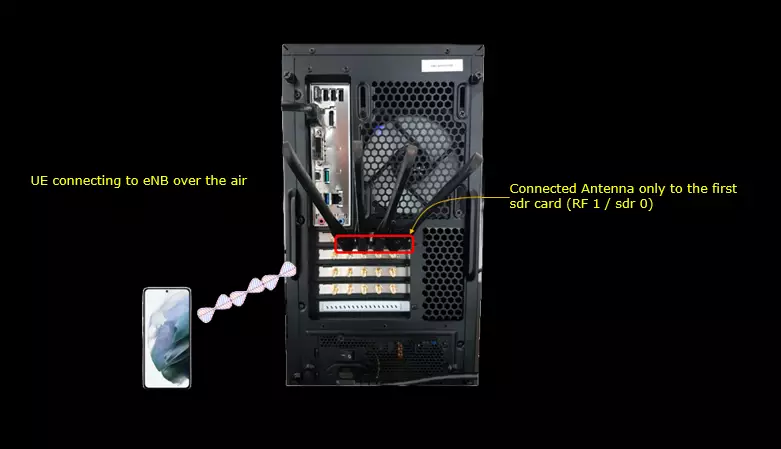
Configuration
This tutorial is checking only on SIB transmission of each radio access technology. You may use any of the configurations that you want.
NR SA Cell Reference Power
Restart lte service and go to screen window. Get the basic phy information of the cell.

Enable SIB logging

Check ss-PBCH-BlockPower
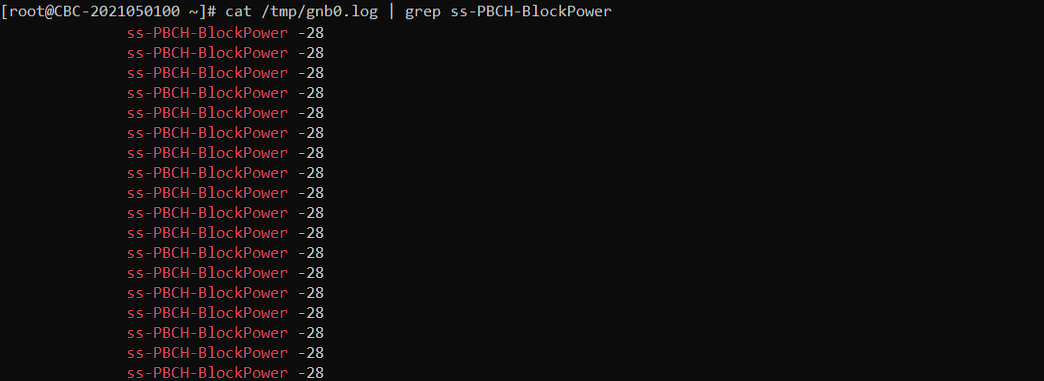
Do some experiments to find the correlation between tx power of the call box and ss-PBCH-BlockPower set by the callbox
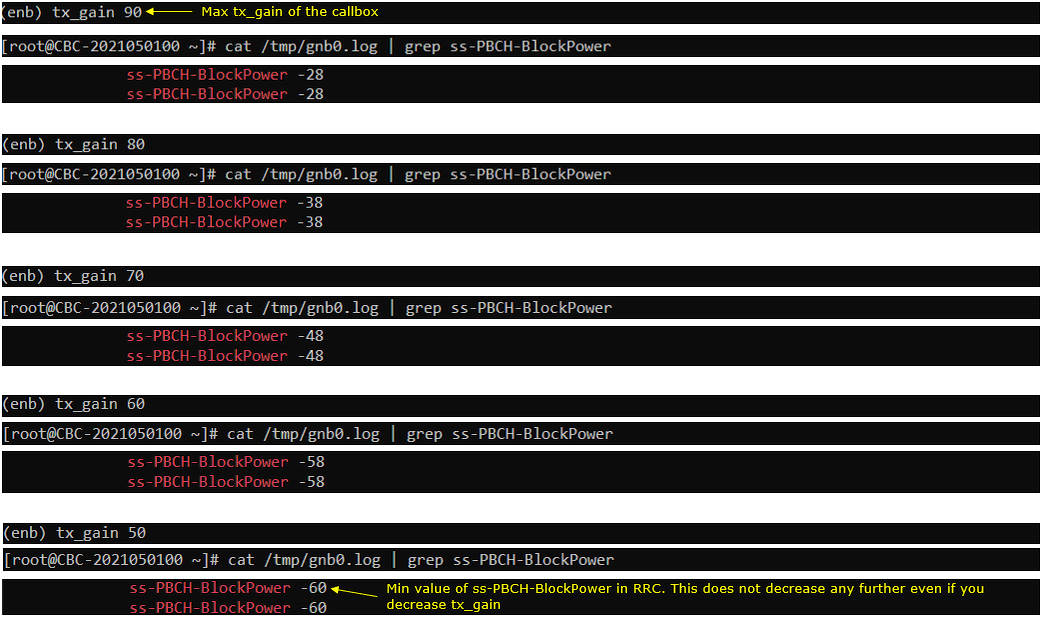
LTE Cell Reference Power
Restart lte service and go to screen window. Get the basic phy information of the cell.

Enable SIB logging

Check referenceSignalPowerr

Do some experiments to find the correlation between tx power of the call box and referenceSignalPower set by the callbox
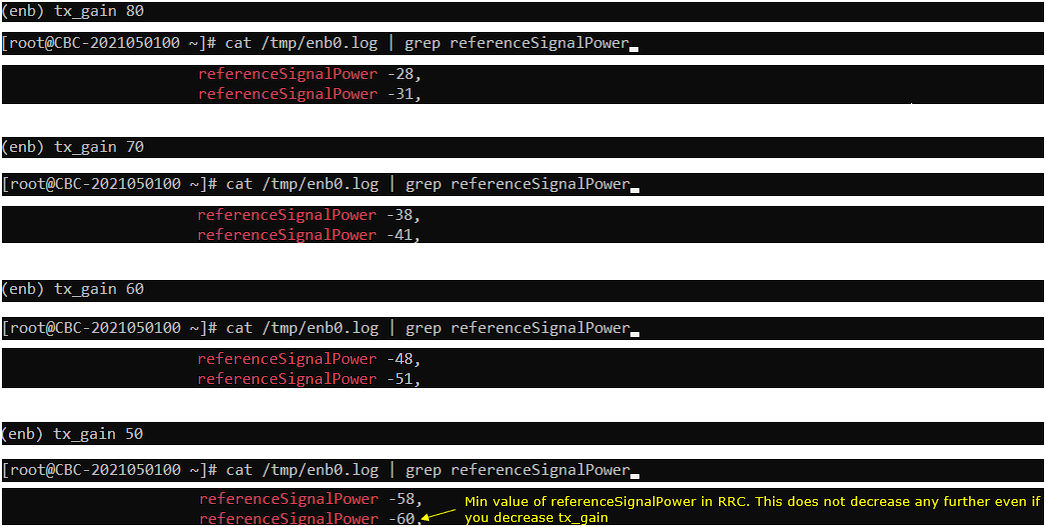
NB IoT Cell Reference Power
Restart lte service and go to screen window. Get the basic phy information of the cell.

Enable SIB logging

Check nrs-Power

Do some experiments to find the correlation between tx power of the call box and nrs-Power set by the callbox
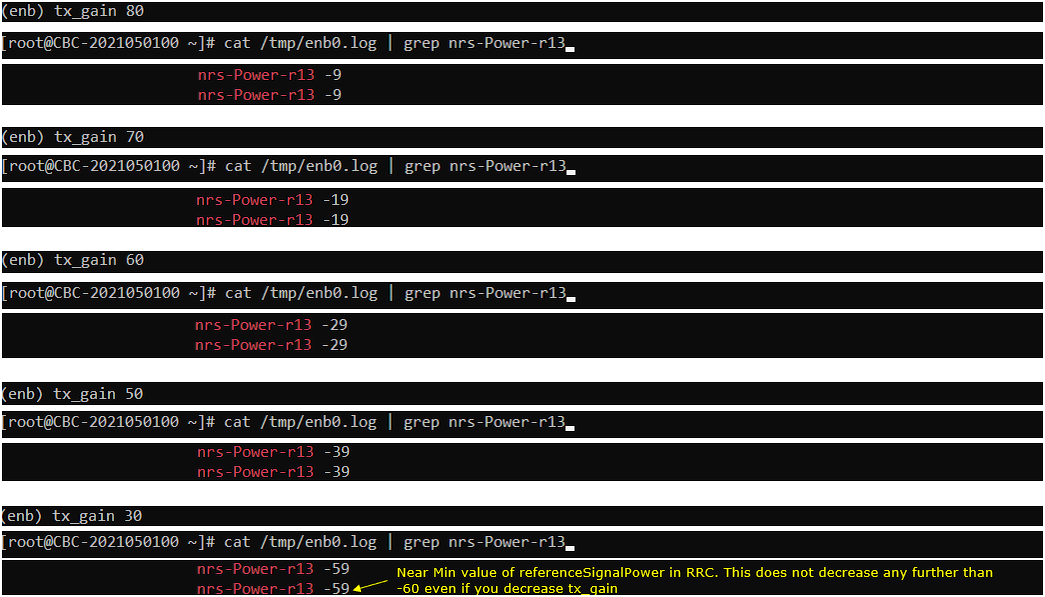
Broadcast Reference Power Variation Among Software Release
In most cases, the reference power broadcast in SIB does not change with Software Release, but in some rare case there might be some changes in the broadcast reference power due to various reasons (e.g, Calibration table adjustment).
Following is one example of Broadcast reference power of NR Cell between the two different software release.
Release 2021-11-17 : NR SA Reference Power in SIB1

Release 2022-04-01 : NR SA Reference Power in SIB1

Broadcast Reference Power Variation with Channel Bandwidth
Broadcast Reference Power varies with Channel Bandwidth As shown below. This is with SDR 50 and Callbox software release 2022-04-01



Tips
Differnce Between tx_gain and cell_gain
There are roughly two different ways to change cell power. One is to use tx_gain and the other is to use cell_gain. Whenever you change tx_gain, the reference power value in SIB gets changed but cell_gain does not change the reference power value in SIB message.